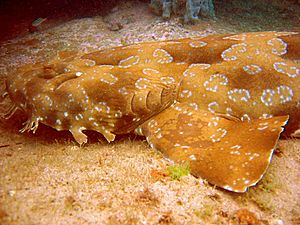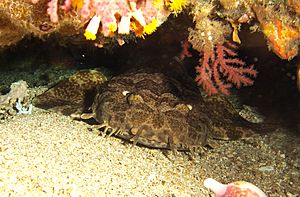Wobbegong facts for kids
Quick facts for kids Wobbegongs |
|
|---|---|
 |
|
| Spotted wobbegong, Orectolobus maculatus, showing the camouflage pattern and skin flaps typical of wobbegongs |
|
| Scientific classification |
|
| Kingdom: | Animalia |
| Phylum: | Chordata |
| Class: | Chondrichthyes |
| Order: | Orectolobiformes |
| Family: | Orectolobidae T. N. Gill, 1896 |
| Genera | |
|
Eucrossorhinus |
|
Wobbegongs are a type of carpet shark. There are 12 different kinds, and they all belong to the family called Orectolobidae. These sharks live in shallow, warm waters. You can find them in the western Pacific Ocean and the eastern Indian Ocean. Most wobbegongs live around Australia and Indonesia.
Contents
What's in a Name?
The name wobbegong comes from an Australian Aboriginal language. It means "shaggy beard." This name probably refers to the special skin growths around the shark's mouth. These growths help them blend in with their surroundings.
Amazing Appearance and Camouflage
Wobbegongs are true masters of disguise! Their bodies are flat and have many different colors. These colors include browns, tans, and sometimes reddish or yellowish shades. This amazing coloring helps them perfectly blend in with the ocean floor.
Each wobbegong species has unique patterns and colors. These patterns depend on where they live. Their incredible camouflage helps them sneak up on prey. It also protects them from bigger predators. Some wobbegongs have patterns that look like rocks or coral. Others have bolder marks to hide in seagrass beds. Their skin is also rough and bumpy, which adds to their disguise.
Their bodies are wide and flat. This shape helps them lie perfectly still on the ocean floor. Their mouths are underneath their heads. Their eyes are on top, giving them a great view all around. Wobbegongs also have long, strong tails. They use their tails for swimming and moving around.
Wobbegongs can be different sizes. They usually range from about 3 feet (1 meter) to almost 10 feet (3 meters) long. The biggest wobbegongs can weigh over 500 pounds (225 kilograms)!
Where Wobbegongs Live
Wobbegongs live in many shallow-water places. These include tropical coral reefs, rocky reefs, and seagrass beds. They like areas with lots of cracks and hiding spots. These spots are perfect for ambushing their prey.
Their geographic range covers the coastal waters of Australia, New Guinea, and parts of the Indian and Pacific Oceans. Different species prefer different homes. Some stay close to the coast. Others swim further out into the ocean.
What Wobbegongs Eat
Wobbegongs are ambush predators. This means they wait quietly for their food to come close. Then, they strike quickly! Their camouflage makes them almost invisible to prey.
They mostly eat small fish, crustaceans (like crabs and shrimps), and cephalopods (like squid and octopus). Wobbegongs are not fast swimmers. So, their ambush hunting style is very important for catching food.
Their teeth are made for gripping and holding onto prey. They have many rows of teeth. If a tooth breaks, a new one moves forward to replace it. This way, they always have sharp teeth for hunting!
Wobbegong Behavior
Wobbegongs usually like to be alone. They are mostly active at night. This is when they leave their hiding spots to hunt. During the day, they rest in cracks or under rocks. They stay perfectly hidden and save their energy.
Even though they are solitary hunters, they are not aggressive towards humans. However, they can bite if they feel threatened. It's always best to watch them from a safe distance.
Wobbegong Reproduction
Wobbegongs are ovoviviparous. This means their eggs grow inside the mother's body. The young are then born live. The number of pups in a litter changes depending on the species. Scientists are still learning a lot about how wobbegongs reproduce.
It's a slow and interesting process. The pups are fully developed when they are born. They can hunt for themselves fairly quickly. This is different from many other types of sharks. Some sharks lay eggs, and others have very different ways of giving birth.
Protecting Wobbegongs
Sadly, many wobbegong species are facing threats. These include habitat destruction, pollution, and fishing. Many wobbegongs get caught by accident in fishing nets. These nets are meant for other fish. This is a common problem for many sharks.
Wobbegongs reproduce slowly. This means their populations take a long time to recover from threats. People are working to protect these amazing creatures. They are doing research to understand wobbegong populations better. They are also trying to reduce "bycatch." Bycatch is when animals are caught unintentionally by fishing boats.
| Species | Common name(s) | IUCN Red List status | Population trend | Reference |
|---|---|---|---|---|
| Eucrossorhinus dasypogon | Tasselled wobbegong | Least concern | Unknown | |
| Orectolobus floridus | Floral banded wobbegong | Least concern | Unknown | |
| Orectolobus halei | Gulf wobbegong, banded wobbegong | Least concern | Stable | |
| Orectolobus hutchinsi | Western wobbegong | Least concern | Unknown | |
| Orectolobus japonicus | Japanese wobbegong | Data deficient | Unknown | |
| Orectolobus leptolineatus | Indonesian wobbegong | Near Threatened | Unknown | |
| Orectolobus maculatus | Spotted wobbegong | Least concern | Unknown | |
| Orectolobus ornatus | Ornate wobbegong | Least concern | Unknown | |
| Orectolobus parvimaculatus | Dwarf spotted wobbegong | Least concern | Unknown | |
| Orectolobus reticulatus | Network wobbegong | Data deficient | Unknown | |
| Orectolobus wardi | Northern wobbegong | Least concern | Unknown | |
| Sutorectus tentaculatus | Cobbler wobbegong | Least concern | Unknown |
Types of Wobbegongs
There are 12 living species of wobbegongs. They are grouped into three main categories, called genera:
- Genus Eucrossorhinus Regan, 1908
- Eucrossorhinus dasypogon (Bleeker, 1867) (tasselled wobbegong)
- †Eucrossorhinus microcuspidatus Case 1978
- Genus Orectolobus Bonaparte, 1834
- Orectolobus floridus Last & Chidlow, 2008 (floral banded wobbegong)
- Orectolobus halei Whitley, 1940. (Gulf wobbegong or banded wobbegong)
- Orectolobus hutchinsi Last, Chidlow & Compagno, 2006. (western wobbegong)
- Orectolobus japonicus Regan, 1906 (Japanese wobbegong)
- Orectolobus leptolineatus Last, Pogonoski & W. T. White, 2010 (Indonesian wobbegong)
- Orectolobus maculatus (Bonnaterre, 1788) (spotted wobbegong)
- Orectolobus ornatus (De Vis, 1883) (ornate wobbegong)
- Orectolobus parvimaculatus Last & Chidlow, 2008 (dwarf spotted wobbegong)
- Orectolobus reticulatus Last, Pogonoski & W. T. White, 2008 (network wobbegong)
- Orectolobus wardi Whitley, 1939 (northern wobbegong)
- Genus Sutorectus Whitley, 1939
- Sutorectus tentaculatus (W. K. H. Peters, 1864) (cobbler wobbegong)
There are also some fossil genera, like:
- Eometlaouia Noubhani & Cappetta, 2002
See also
 In Spanish: Orectolóbidos para niños
In Spanish: Orectolóbidos para niños


